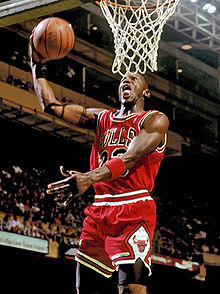National Basketball Association
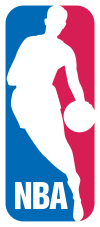
History of the NBA (1949-2011)

Video of clips from the beginning of the NBA till now. I made this video for a school project. The video is in HD. It has footage of LeBron James, Kobe Bryant, Michael Jordan, Ervin “magic” johnson, Dwayne Wade, Bill Russell, Larry Bird and many other stars. Footage from all the National Basketball Association teams. Fottage from the 1940’s, 1950’s, 1960’s, 1970’s, 1980’s, 1990’s, 2000’s. Playoff/ Finals plays: dunks blocks buzzer beaters game winners.
 The National Basketball Association (NBA) is the pre-eminent men’s professional basketball league in North America. With thirty franchised member clubs (29 in the United States and 1 in Canada), the NBA is widely considered to be the premier men’s professional basketball league in the world. It is an active member of USA Basketball (USAB), which is recognized by FIBA(also known as the International Basketball Federation) as the national governing body for basketball in the United States. The NBA is one of the 4 major North American professional sports leagues. NBA players are the world’s best paid sportsmen, by average annual salary per player.
The National Basketball Association (NBA) is the pre-eminent men’s professional basketball league in North America. With thirty franchised member clubs (29 in the United States and 1 in Canada), the NBA is widely considered to be the premier men’s professional basketball league in the world. It is an active member of USA Basketball (USAB), which is recognized by FIBA(also known as the International Basketball Federation) as the national governing body for basketball in the United States. The NBA is one of the 4 major North American professional sports leagues. NBA players are the world’s best paid sportsmen, by average annual salary per player.
The league was founded in New York City on June 6, 1946 as the Basketball Association of America (BAA). The league adopted the name National Basketball Association in 1949 after merging with the rival National Basketball League (NBL). The league’s several international as well as individual team offices are directed out of its head offices located in the Olympic Tower at 645 Fifth Avenue in New York City. NBA Entertainment and NBA TV studios are directed out of offices located in Secaucus, New Jersey.
History – Creation and merger
Basketball Association of America
The Basketball Association of America was founded in 1946 by owners of the major ice hockey arenas in the Northeastern and Midwestern United States and Canada. On November 1, 1946, in Toronto, Ontario, Canada, the Toronto Huskies hosted the New York Knickerbockers at Maple Leaf Gardens, in a game the NBA now regards as the first played in its history. Although there had been earlier attempts at professional basketball leagues, including the American Basketball League and the NBL, the BAA was the first league to attempt to play primarily in large arenas in major cities. During its early years, the quality of play in the BAA was not significantly better than in competing leagues or among leading independent clubs such as the Harlem Globetrotters. For instance, the 1948 ABL finalist Baltimore Bullets moved to the BAA and won that league’s 1948 title, and the 1948 NBL champion Minneapolis Lakers won the 1949 BAA title.
On August 3, 1949, the BAA agreed to merge with the NBL, creating the new National Basketball Association. The new league had seventeen franchises located in a mix of large and small cities, as well as large arenas and smaller gymnasiums and armories. In 1950, the NBA consolidated to eleven franchises, a process that continued until 1953–54, when the league reached its smallest size of eight franchises, all of which are still in the league (the New York Knicks,Boston Celtics, Golden State Warriors, Los Angeles Lakers, Royals/Kings, Detroit Pistons, Atlanta Hawks, and Nationals/76ers). The process of contraction saw the league’s smaller-city franchises move to larger cities. The Hawks shifted from “Tri-Cities” (the area now known as the Quad Cities) to Milwaukee (in 1951) and then to St. Louis, Missouri (in 1955); the Royals from Rochester, New York to Cincinnati (in 1957); and the Pistons from Fort Wayne, Indiana to Detroit (in 1957).
Although Japanese-American Wataru Misaka technically broke the NBA color barrier in the 1947–48 season when he played for the New York Knicks, 1950 is recognized as the year the NBA integrated. This year witnessed the addition of African American players by several teams, including Chuck Cooper with the Celtics, Nathaniel “Sweetwater” Clifton with the Knicks, and Earl Lloyd with theWashington Capitols. During this period, the Minneapolis Lakers, led by center George Mikan, won five NBA Championships and established themselves as the league’s first dynasty. To encourage shooting and discourage stalling, the league introduced the 24-second shot clock in 1954. If a team does not attempt to score a field goal (or the ball fails to make contact with the rim) within 24 seconds of obtaining the ball, play is stopped and the ball given to its opponent.
Celtics’ dominance, league expansion, and competition
In 1957, rookie center Bill Russell joined the Boston Celtics, who already featured guard Bob Cousy and coach Red Auerbach, and went on to lead the club to eleven NBA titles in thirteen seasons. Center Wilt Chamberlain entered the league with the Warriors in 1959 and became a dominant individual star of the 1960s, setting new single game records in scoring (100) and rebounding (55). Russell’s rivalry with Chamberlain became one of the greatest in the history of American team sports.
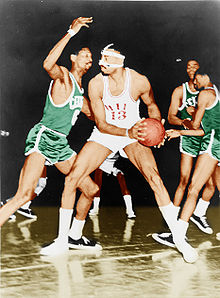 Bill Russell defending Wilt Chamberlain in 1966.
Bill Russell defending Wilt Chamberlain in 1966.
The 1960s were dominated by the Celtics. Led by Russell, Bob Cousy and coach Red Auerbach, Boston won eight straight championships in the NBA from the 1959–66. This championship streak is the longest in NBA history. They did not win the title in 1966-67, but regained it in the 1967-68 season and repeated in 1969. The domination totaled nine of the 10 championship banners of the 1960s.
Through this period, the NBA continued to strengthen with the shift of the Minneapolis Lakers to Los Angeles, the Philadelphia Warriors to San Francisco, the Syracuse Nationals to Philadelphia to become the Philadelphia 76ers, and the St. Louis Hawksmoving to Atlanta, as well as the addition of its first expansion franchises. The Chicago Packers (now Washington Wizards) became the ninth NBA team in 1961. From 1966 to 1968, the league expanded from 9 to 14 teams, introducing the Chicago Bulls, Seattle SuperSonics (now Oklahoma City Thunder), San Diego Rockets (who relocated to Houston four years later), Milwaukee Bucks, and Phoenix Suns.
In 1967, the league faced a new external threat with the formation of the American Basketball Association (ABA). The leagues engaged in a bidding war. The NBA landed the most important college star of the era, Kareem Abdul-Jabbar (then known as Lew Alcindor). However, the NBA’s leading scorer, Rick Barry, jumped to the ABA, as did four veteran referees—Norm Drucker, Earl Strom, John Vanak, and Joe Gushue.
In 1969, Alan Siegel, who oversaw the design of Jerry Dior’s Major League Baseball logo a year prior, created the modern NBA logo inspired by the MLB’s. It incorporates the silhouette of the legendary Jerry West based on a photo by Wen Roberts, although NBA officials denied a particular player as being its influence because, according to Siegel, “They want to institutionalize it rather than individualize it. It’s become such a ubiquitous, classic symbol and focal point of their identity and their licensing program that they don’t necessarily want to identify it with one player.” The iconic logo debuted in 1971 and would remain a fixture of the NBA brand.
The ABA succeeded in signing a number of major stars in the ’70s, including Julius Erving of the Virginia Squires, in part because it allowed teams to sign college undergraduates. The NBA expanded rapidly during this period, one purpose being to tie up the most viable cities. From 1966 to 1974, the NBA grew from nine franchises to 18. In 1970, the Portland Trail Blazers, Cleveland Cavaliers, and Buffalo Braves (now the Los Angeles Clippers) all made their debuts expanding the league to 17. The New Orleans Jazz (now in Utah) came aboard in 1974 bringing the total to 18. Following the 1976 season, the leagues reached a settlement that provided for the addition of four ABA franchises to the NBA, raising the number of franchises in the league at that time to 22. The franchises added were the San Antonio Spurs, Denver Nuggets, Indiana Pacers, and New York Nets (now the Brooklyn Nets). Some of the biggest stars of this era were Kareem Abdul-Jabbar, Rick Barry, Dave Cowens, Julius Erving, Elvin Hayes, Walt Frazier, Moses Malone, Artis Gilmore, George Gervin, Dan Issel, and Pete Maravich. The end of the decade, however, saw declining TV ratings, low attendance and drug-related player issues – both perceived and real – that threatened to derail the NBA.
Surging popularity
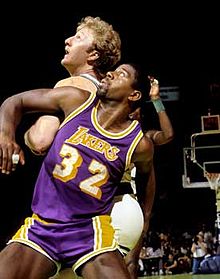 Los Angeles Lakers Magic Johnson and Boston Celtics Larry Bird in Game Two of the 1985 NBA Finals at Boston Garden.
Los Angeles Lakers Magic Johnson and Boston Celtics Larry Bird in Game Two of the 1985 NBA Finals at Boston Garden.
The league added the ABA’s innovative three-point field goal beginning in 1979 to open up the game. That same year, rookies Larry Bird and Magic Johnson joined the Boston Celtics and Los Angeles Lakers respectively, initiating a period of significant growth in fan interest in the NBA throughout the country and the world. In 1984 they played against each other for the first time in the NBA Finals. Johnson went on to lead the Lakers to five titles, and Bird went on to lead the Celtics to three. Also in the early ’80s, the NBA added one more expansion franchise, the Dallas Mavericks, bringing the total to 23 teams. Later on, Larry Bird won the first three three-point shooting contests. Current league commissioner David Stern took office on April 1, 1984, and oversaw the expansion and growth of the NBA to a global commodity.
Michael Jordan entered the league in 1984 with the Chicago Bulls, providing an even more popular star to support growing interest in the league. This resulted in more cities demanding teams of their own. In 1988 and 1989, four cities got their wishes as the Charlotte Hornets, Miami Heat, Orlando Magic, and Minnesota Timberwolves made their NBA debuts, bringing the total to 27 teams. In the first year of the 1990s, the Detroit Pistons would win the second of their back-to-back titles, led by Chuck Daly and Isiah Thomas. Jordan and Scottie Pippen would lead the Bulls to two three-peats in eight years during the 1991–98 seasons. Hakeem Olajuwon won back-to-back titles with the Houston Rockets in ’94 and ’95.
The 1992 Olympic basketball Dream Team, the first to use current NBA stars, featured Michael Jordan as the anchor, along with Bird, Magic, David Robinson, Patrick Ewing, Scottie Pippen, Clyde Drexler, Karl Malone, John Stockton, Chris Mullin, Charles Barkley, and Christian Laettner.
In 1995, the NBA expanded to Canada with the addition of the Vancouver Grizzlies and the Toronto Raptors. In 2001, the Vancouver Grizzlies relocated to Memphis, which left the Raptors as the only Canadian team in the NBA. In 1996, the NBA created a women’s league, the Women’s National Basketball Association (WNBA). In 1998, the NBA owners began a lockout which lasted 191 days and was settled on January 18, 1999. As a result of this lockout the 1998–99 NBA seasonwas reduced from 82 to 50 games (61% of a normal season), and the All-Star Game was cancelled. The San Antonio Spurs won their first championship, and first by a former ABA team, by beating the New York Knicks, who were the first, and to this date, the only, eighth seed to ever make the NBA Finals.
Modern era
Since the breakup of the Chicago Bulls championship roster in the summer of 1998, the Western Conference has dominated, with the Los Angeles Lakers and San Antonio Spurs combining to win the title in nine of fourteen years. Tim Duncan and David Robinson won the 1999 championship with the Spurs, and Shaquille O’Neal and Kobe Bryant started the 2000s with three consecutive championships for the Lakers. The Spurs reclaimed the title in 2003 against the Nets. In 2004, the Lakers returned to the Finals, only to fall in five games to the Detroit Pistons.
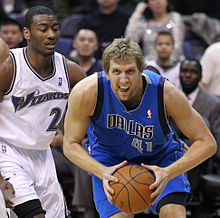 Dirk Nowitzki and John Wall in action at the Dallas Mavericks vs Washington Wizards game on February 26, 2011
Dirk Nowitzki and John Wall in action at the Dallas Mavericks vs Washington Wizards game on February 26, 2011
After the Spurs took home the Larry O’Brien Championship Trophy in 2005, the 2006 Finals featured two franchises making their inaugural Finals appearances. The Miami Heat, led by their star shooting guard, Dwyane Wade, and Shaquille O’Neal, who had been traded from the Lakers during the 2004 summer, won the series over the Dallas Mavericks in 6 after losing the first two games. The Lakers/Spurs dominance continued in 2007 with a four-game sweep by the Spurs over the Cleveland Cavaliers, who were led by LeBron James. The 2008 Finals saw a rematch of the league’s highest profile rivalry, the Boston Celtics and Los Angeles Lakers, with the Celtics prevailing, for their league leading 17th championship, thanks to their new big three of Paul Pierce, Ray Allen, and Kevin Garnett.
In 2009, the Lakers with Kobe Bryant returned to the Finals, this time defeating the Dwight Howard-led Orlando Magic. Kobe Bryant won his first Bill Russell NBA Finals Most Valuable Player Award award in his 13th season after leading the Lakers to their first NBA championship since the departure of Shaquille O’Neal.
The 2010 NBA All-Star Game was held at Cowboys Stadium in front of the largest crowd ever, 108,713. At the end of that season, the Celtics and the Lakers renewed their rivalry from 2008 when they met again in the NBA Finals for a record 12th time. The Lakers won the title in Game 7, 83–79. Before the start of the 2010–11 season the NBA had an exciting summer with one of the most anticipated free agent classes of all time. Two of which signed, and one resigned, with the Miami Heat, leading to a season that was heavily centered on their eventual success or failure at taking home the championship. The Heat, led by LeBron James, Dwyane Wade, and Chris Bosh, did in fact make the Finals against the Dallas Mavericks, in a rematch for the franchises of the 2006 Finals. The Mavericks, led by Dirk Nowitzki (the eventual NBA Finals MVP), took the series in six games. This was the Mavericks’ first title. Other veterans like Shawn Marion, Jason Kidd, and Jason Terry also won their first titles with Nowitzki.
On July 1, 2011, at 12:01 a.m., the NBA announced another lockout. After the first few weeks of the season were canceled, the players and owners ratified a new collective bargaining agreement on December 8, 2011, setting up a shortened 66-game season.

